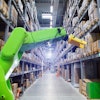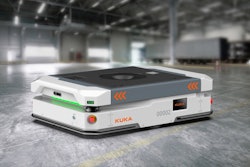
As we enter 2025, the push toward automation adoption in warehouses and distribution centers continues to intensify. With 76% of supply chain and logistics decision-makers citing notable labor shortages, the pressure to enhance productivity while addressing workforce challenges is significant.
Autonomous mobile robots (AMRs) are emerging as a key solution to these demands, offering a way to streamline operations and improve cleanliness all while reducing the strain of manual labor. Cleanliness in food logistics is a critical part of pest management and part of maintaining compliance to food safety regulations. The global market for cleaning robotics is projected to grow at a CAGR of 22.9% from 2024 to 2030, underscoring their growing role in warehouse operations.
Still, AMR adoption doesn’t come without hurdles. Questions about upfront costs, operational impacts and employee buy-in can often create barriers. Discovering the right approach, organizations can make considerable strides in streamlining operations, reducing manual labor demands, and achieving measurable ROI.
Here are three tested strategies to help organizations ensure that AMRs can be successfully deployed into their operations.
Start small, scale smart
Large-scale rollout is an understandable concern for warehouses concerned about potential disruption. So, start small.
Piloting AMRs in a limited capacity helps to mitigate risk and grants an opportunity to more closely manage and plan for a potential transition. By initially deploying a smaller number of units, organizations can test the technology in real-world conditions, work out any operational kinks and fine-tune processes. This phased approach helps minimize the impact of the implementation phase and provides acute insights into how AMRs can integrate and complement existing workflows.
As the pilot phase progresses and adjustments are made, expanding AMR adoption across additional locations becomes far more feasible and effective. By monitoring a smaller, more manageable fleet in a controlled environment, warehouse managers have the flexibility to adapt their expectations and strategies based on real-time performance data drawn from their own unique facility.
For facilities considering implementing AMRs, scaling up from an initial test set to a more expansive rollout across additional locations becomes a much more seamless process, minimizing operational disruptions and promoting smoother integration. Starting small provides the pressure test and proof for warehouse managers and decision-makers to feel confident about their investment.
Prioritize operator buy-in
One will have difficulty talking about AMRs without acknowledging the “employee buy-in” question. Because this technology can bring significant change, it’s critical to earn operator confidence from the start.
For a successful implementation, engage warehouse staff early in the process, provide thorough training on the machines that will be working alongside them, and make time to answer questions and address concerns. Prioritizing buy-in has the dual benefit of increasing operator confidence while also garnering enthusiasm for AMRs.
When employees understand the value of AMRs — particularly in terms of alleviating the more menial, everyday cleaning burden, improving workplace safety and assisting operations — they are much more likely to not only embrace the change, but become champions of it. Initial questions are typical and understandable, but by providing clear explanations of how AMRs work and the direct benefits they bring, organizations can facilitate smoother adoption.
Employee enthusiasm is not just helpful for AMR adoption — it can also directly scale their usage. Dedicated training and ongoing dialogue with staff will prove essential to guaranteeing this enthusiasm for the operators who will be interfacing with the technology on a daily basis. Because AMRs can handle the more repetitive, lower-skill tasks, employees are freed up to focus on higher-value activities that require human decision-making and oversight.
With operator buy-in, adoption is easier, and scaling is faster, paving the way for a stronger ROI.
Pick a proven AMR partner
Adopting an emerging technology of any kind is never without initial hurdles or unforeseen obstacles to overcome. That’s why choosing the right partner for your AMR solution is critical to long-term success. Selecting a manufacturer committed to supporting your needs throughout the entire lifecycle of the equipment is imperative so take your time and vet potential partners thoroughly.
A strong partnership means that when challenges arise — whether it’s troubleshooting technical issues, training new staff or adapting to evolving operational needs — you have a trusted, reliable resource to lean on. Robust support is vital, but it’s just as important that the support is accessible when you need it most. Having a partner that makes support as accessible as it is helpful can make all the difference between a smooth AMR implementation and one bogged down by unnecessary delays or disruptions.
Moreover, selecting a partner with the big picture in mind ensures that your operations continue to improve, optimize and provide greater returns over time. Technology advances, business needs shift and logistical priorities change. With ongoing support from a partner committed to your success, a reality where your AMRs remain assets for years to come becomes much more likely.
AMRs represent an exciting opportunity to transform operations, and while their implementation may seem daunting, it doesn’t have to be. With a thoughtful approach, strong employee engagement and the right support, organizations can confidently integrate AMRs to drive ROI and enhance overall efficiency.





















